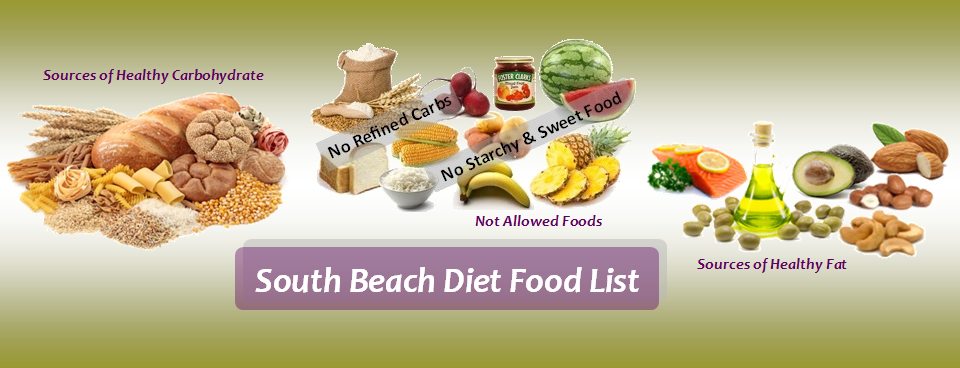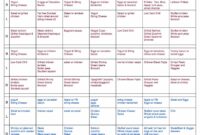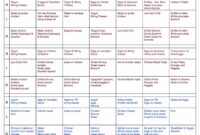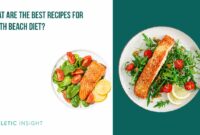What to eat on the South Beach Diet? This question guides many seeking a healthier lifestyle. The South Beach Diet, known for its phased approach, focuses on prioritizing healthy fats and lean proteins while carefully managing carbohydrate intake. This approach differs significantly from many other diets, emphasizing sustainable weight loss through mindful food choices rather than restrictive calorie counting. Understanding the nuances of each phase – from the initial restriction of certain carbohydrates to the gradual reintroduction in later stages – is crucial for success.
This guide delves into the specifics of what constitutes an acceptable meal plan, offering a range of breakfast, lunch, and dinner options suitable for each phase. We’ll explore recipe ideas, snack suggestions, and address common concerns individuals encounter while following this popular diet plan, aiming to provide a comprehensive resource for those embarking on their South Beach journey.
Breakfast Options on the South Beach Diet
The South Beach Diet, particularly in its initial phases, emphasizes low-glycemic foods to promote stable blood sugar levels and weight loss. Choosing the right breakfast is crucial for setting the tone for the entire day and adhering to the diet’s principles. This section will explore breakfast options suitable for both Phase 1 and Phase 2 of the South Beach Diet.
Phase 1 Breakfast Recipes
Phase 1 of the South Beach Diet focuses on eliminating high-glycemic carbohydrates and unhealthy fats. The following recipes provide delicious and nutritious breakfast options that align with these restrictions.
- Omelet with Spinach and Mushrooms: Whisk two eggs with a splash of milk and season with salt and pepper. Sauté a handful of spinach and sliced mushrooms in a tablespoon of olive oil. Pour the egg mixture over the vegetables and cook until set. This provides protein, healthy fats, and essential vitamins.
- Smoked Salmon and Avocado Toast: Top a slice of whole-wheat toast (check carbohydrate content to ensure it fits Phase 1 guidelines) with smoked salmon and sliced avocado. This offers healthy fats, protein, and fiber.
- Cottage Cheese with Berries: Combine 1/2 cup of low-fat cottage cheese with a small serving of berries (such as blueberries or strawberries). This provides protein and antioxidants.
- Greek Yogurt with Nuts and Seeds: Mix plain, nonfat Greek yogurt with a tablespoon of chopped nuts (almonds, walnuts) and chia seeds. This combination delivers protein, healthy fats, and fiber.
- Scrambled Eggs with Tomatoes and Onions: Scramble two eggs with diced tomatoes and onions, seasoned with herbs and spices. This provides protein and essential nutrients.
Phase 2 Breakfast Ideas
Phase 2 of the South Beach Diet introduces a wider variety of foods, including some fruits and whole grains. These quick and easy breakfast ideas maintain the diet’s principles while offering more flexibility.
- Berry Smoothie: Blend unsweetened almond milk, a handful of berries, a scoop of protein powder (whey or plant-based), and a tablespoon of chia seeds. This is a quick and nutritious option packed with antioxidants and protein.
- Whole-wheat Toast with Peanut Butter: A slice of whole-wheat toast topped with a small amount of natural peanut butter provides protein, fiber, and healthy fats. Ensure the peanut butter is low in added sugar.
- Oatmeal with Berries and Nuts: Prepare oatmeal using water or unsweetened almond milk. Top with berries and a sprinkle of chopped nuts. Choose steel-cut or rolled oats for optimal fiber content.
- Breakfast Burrito (modified): Use a whole-wheat tortilla (check carbohydrate content) and fill it with scrambled eggs, black beans, and salsa. This provides protein, fiber, and healthy carbohydrates.
- Leftovers: Repurpose leftover grilled chicken or fish from dinner into a quick and easy breakfast. This is a convenient way to incorporate protein and healthy fats.
A Balanced South Beach Diet Breakfast Plate
Imagine a plate divided into three sections.
| Section | Food Item | Nutritional Contribution |
|---|---|---|
| 1/3 Plate | Scrambled eggs (2) | High-quality protein, essential amino acids |
| 1/3 Plate | Spinach and mushroom sauté | Vitamins, minerals, fiber, antioxidants |
| 1/3 Plate | Small portion of sliced avocado | Healthy monounsaturated fats, fiber |
This balanced breakfast plate provides a good source of protein, healthy fats, and essential vitamins and minerals, all while adhering to the principles of the South Beach Diet. The visual representation emphasizes the importance of portion control and a variety of nutrient-rich foods.
Lunch and Dinner Ideas for the South Beach Diet
The South Beach Diet emphasizes lean protein, healthy fats, and plenty of non-starchy vegetables. Successfully navigating the lunch and dinner portions of this diet requires careful planning and an understanding of appropriate food combinations. This section will provide practical recipes and a sample meal plan to illustrate how to construct satisfying and diet-compliant meals.
Five Lunch Recipes Focusing on Lean Protein and Healthy Fats
These lunch recipes are designed to be versatile and suitable for all phases of the South Beach Diet. They prioritize lean protein sources, healthy fats, and a balance of nutrients to keep you feeling full and energized throughout the afternoon. Remember to adjust portion sizes according to your individual caloric needs.
- Mediterranean Quinoa Salad: Cooked quinoa, chopped cucumber, tomatoes, red onion, Kalamata olives, crumbled feta cheese (use sparingly in early phases), and a lemon-herb vinaigrette. This provides complex carbohydrates, protein, and healthy fats.
- Grilled Chicken Salad with Avocado: Grilled chicken breast (or fish like salmon), mixed greens, avocado slices, a handful of almonds, and a light vinaigrette. This offers lean protein, healthy fats from the avocado and almonds, and fiber from the greens.
- Tuna Salad Lettuce Wraps: Canned tuna in water (packed in olive oil is acceptable in later phases), celery, red onion, a touch of mayonnaise (consider Greek yogurt as a substitute), and served in crisp lettuce cups. This is a lower-carb alternative to traditional tuna salad.
- Leftover Dinner Re-purposed: A simple and efficient strategy is to repurpose leftover dinner into a quick and easy lunch. For example, leftover grilled salmon and vegetables can be enjoyed cold or at room temperature.
- Shrimp and Avocado Skewers: Grilled shrimp skewers served with a side of sliced avocado. This provides a protein-rich meal with healthy fats and minimal carbohydrates.
Five Dinner Recipes Emphasizing Vegetables and Lean Protein Sources (Phase 3 Compliant)
These dinner recipes are specifically tailored to Phase 3 of the South Beach Diet, allowing for a wider variety of fruits and carbohydrates. They maintain a focus on lean protein and abundant vegetables.
- Baked Salmon with Roasted Asparagus and Sweet Potatoes: Baked salmon fillet seasoned with herbs and lemon, roasted asparagus spears, and a small portion of roasted sweet potatoes. This provides omega-3 fatty acids, protein, and a good source of vitamins and minerals.
- Chicken Stir-fry with Brown Rice: Chicken breast stir-fried with a variety of colorful vegetables (broccoli, carrots, peppers, snap peas) and served over a small portion of brown rice. Use a low-sodium soy sauce or tamari for flavor.
- Turkey Meatloaf with Steamed Green Beans: A lean turkey meatloaf made with ground turkey, finely chopped vegetables (onions, carrots), and herbs, served with steamed green beans. This is a hearty and satisfying meal.
- Lentil Soup with Whole-Wheat Bread (small portion): A hearty lentil soup packed with vegetables and fiber, served with a small slice of whole-wheat bread. This is a high-fiber, protein-rich option.
- Chicken and Vegetable Skewers with Quinoa: Chicken breast and assorted vegetables (bell peppers, zucchini, onions) grilled on skewers, served over a small portion of cooked quinoa. This offers lean protein, fiber, and complex carbohydrates.
Weekly Meal Plan Incorporating Diverse Recipes
This sample meal plan incorporates recipes from the lunch and dinner examples, ensuring variety and adherence to the South Beach Diet principles. Remember to adjust portion sizes based on individual needs and activity levels.
| Day | Lunch | Dinner |
|---|---|---|
| Monday | Mediterranean Quinoa Salad | Baked Salmon with Roasted Asparagus and Sweet Potatoes |
| Tuesday | Grilled Chicken Salad with Avocado | Chicken Stir-fry with Brown Rice |
| Wednesday | Tuna Salad Lettuce Wraps | Turkey Meatloaf with Steamed Green Beans |
| Thursday | Leftover Dinner | Lentil Soup with Whole-Wheat Bread (small portion) |
| Friday | Shrimp and Avocado Skewers | Chicken and Vegetable Skewers with Quinoa |
| Saturday | Mediterranean Quinoa Salad | Baked Salmon with Roasted Asparagus and Sweet Potatoes |
| Sunday | Leftover Dinner | Chicken Stir-fry with Brown Rice |
Snacks and Beverages on the South Beach Diet
The South Beach Diet emphasizes healthy choices, even when it comes to snacks and beverages. Maintaining energy levels and avoiding blood sugar spikes are key to successful weight management, and choosing the right snacks and drinks plays a crucial role in achieving this. Proper hydration is also essential for overall health and well-being.
Careful snack selection helps prevent hunger pangs and keeps you satisfied between meals, preventing you from reaching for unhealthy options. Similarly, choosing the right beverages supports your body’s natural processes and aids in weight loss. This section details appropriate snack and beverage choices throughout the different phases of the South Beach Diet.
Healthy Snack Options for All Phases
These five snack options are generally permissible throughout all phases of the South Beach Diet, providing a balance of protein, healthy fats, and fiber to keep you feeling full and energized.
- A small handful of almonds or other unsalted nuts: Almonds are rich in healthy fats, fiber, and protein, contributing to satiety and providing sustained energy.
- Hard-boiled eggs: Eggs are an excellent source of protein and essential nutrients, promoting fullness and supporting muscle mass.
- A small portion of Greek yogurt (plain, unsweetened): Greek yogurt is high in protein and probiotics, beneficial for gut health and promoting a feeling of fullness.
- Celery sticks with a small amount of almond butter: This combination offers fiber from the celery and healthy fats and protein from the almond butter.
- A small piece of fruit (berries are preferred): Berries are low in sugar compared to other fruits and provide antioxidants and fiber.
The Importance of Hydration and Suitable Beverages
Staying adequately hydrated is crucial for overall health and particularly important during weight loss. Water plays a vital role in numerous bodily functions, including metabolism, nutrient absorption, and waste removal. Dehydration can lead to fatigue, decreased metabolism, and even mistaken hunger pangs.
The South Beach Diet encourages the consumption of plenty of water throughout the day. Other suitable beverages include unsweetened tea (herbal or green tea are excellent choices) and black coffee (without added sugar or cream). Avoid sugary drinks, juices, and sodas, as these can hinder weight loss efforts.
Sample Snack Chart Based on Phase Suitability
This chart provides examples of snacks suitable for each phase. Remember to always check the specific guidelines for each phase of the South Beach Diet for the most accurate and up-to-date information.
| Phase | Suitable Snacks | Snacks to Avoid |
|---|---|---|
| Phase 1 | Hard-boiled eggs, celery with almond butter, berries | Fruit juices, granola bars, pretzels |
| Phase 2 | Small handful of almonds, Greek yogurt, vegetables with hummus (made with olive oil) | Bread, pastries, most processed snacks |
| Phase 3 | All snacks from Phase 1 and 2, plus a wider variety of fruits and vegetables | Highly processed foods, sugary snacks |
Addressing Common Concerns and Challenges
Embarking on the South Beach Diet, like any dietary change, presents potential hurdles. Understanding these common challenges and proactively implementing strategies for overcoming them is crucial for successful weight management and sustained adherence. This section addresses common pitfalls, methods for managing hunger and cravings, and advice for long-term commitment to the diet.
Common Pitfalls to Avoid
Successfully navigating the South Beach Diet requires awareness of potential pitfalls. One common mistake is overly restrictive adherence, leading to feelings of deprivation and eventual relapse. Another is neglecting to carefully read food labels, potentially consuming hidden sugars or unhealthy fats. Finally, insufficient planning, leading to impulsive unhealthy food choices when hunger strikes, can significantly hinder progress. Avoiding these pitfalls involves careful meal planning, diligent label reading, and a mindful approach to food choices.
Managing Hunger and Cravings
Hunger and cravings are frequently cited challenges on any weight-loss journey, including the South Beach Diet. Effective strategies for managing these sensations include prioritizing protein and healthy fats in meals and snacks. These nutrients promote satiety, keeping you feeling fuller for longer. Furthermore, staying well-hydrated by drinking plenty of water can help differentiate between true hunger and thirst. Finally, incorporating regular physical activity can help curb cravings and boost overall well-being. Remember, listening to your body’s cues and choosing satisfying, diet-compliant options are key.
Maintaining Long-Term Adherence
Sustaining any diet long-term requires a shift in lifestyle rather than a temporary fix. For the South Beach Diet, this means integrating the principles of the diet into your everyday life. This includes focusing on balanced meals with lean proteins, healthy fats, and plenty of vegetables. Finding enjoyable, diet-friendly recipes and meal preparation methods can significantly improve long-term adherence. Moreover, seeking support from friends, family, or support groups can provide encouragement and accountability. Remember, sustainable weight management is a marathon, not a sprint. Focusing on gradual, healthy changes, rather than rapid weight loss, is more likely to lead to lasting success.
Supplementing the South Beach Diet
The South Beach Diet, while effective for weight loss, may lead to certain nutritional deficiencies if not carefully managed. Understanding potential shortfalls and how to address them through dietary adjustments and, in some cases, supplementation, is crucial for long-term health and well-being. This section will explore these aspects, focusing on responsible supplementation strategies.
Potential Nutritional Deficiencies and Dietary Modifications
Restricting certain food groups, as the South Beach Diet does in its initial phases, can potentially lead to insufficient intake of specific vitamins and minerals. For instance, limiting fruits initially might reduce vitamin C intake, while restricting whole grains could decrease fiber and certain B vitamins. Addressing these deficiencies primarily involves careful planning and strategic food choices within the diet’s framework. Increasing intake of permitted fruits and vegetables rich in vitamin C (like bell peppers and berries) and incorporating whole grains once they are reintroduced will help mitigate these potential issues. Prioritizing nutrient-dense foods throughout the diet’s phases is key to minimizing the risk of deficiencies.
The Role of Vitamins and Minerals in the South Beach Diet
Vitamins and minerals are essential micronutrients vital for numerous bodily functions, including metabolism, energy production, and immune function. The South Beach Diet, focusing on lean proteins, healthy fats, and non-starchy vegetables, can provide a good source of many essential vitamins and minerals. However, it’s crucial to ensure a balanced intake across all food groups, particularly as the diet progresses.
Sufficient intake of B vitamins is important for energy metabolism, and deficiencies can lead to fatigue. The diet’s emphasis on lean protein sources can help supply some B vitamins, but attention should be paid to ensuring adequate intake through varied food choices.
Vitamin D, crucial for calcium absorption and bone health, might require attention, as dietary sources can be limited. Consider sun exposure or supplementation if needed, especially if dietary intake is insufficient.
Potential Benefits and Risks of Using Supplements with the South Beach Diet
Supplementation can be considered in situations where dietary modifications alone are insufficient to address identified nutritional gaps. However, it’s crucial to approach supplementation cautiously. The benefits lie in potentially filling nutritional voids and supporting overall health. For example, a multivitamin could help ensure a broad spectrum of micronutrients are met.
However, risks exist. Unnecessary supplementation can lead to potential interactions with medications or existing health conditions. Furthermore, relying heavily on supplements might overshadow the importance of obtaining nutrients through a balanced, whole-foods diet. Therefore, supplementation should be approached thoughtfully, ideally under the guidance of a healthcare professional or registered dietitian, who can assess individual needs and guide appropriate choices. Self-prescribing supplements can be risky and should be avoided.
Final Review
Successfully navigating the South Beach Diet hinges on understanding its principles and consistently applying them. From carefully selecting breakfast options rich in protein and healthy fats to creating balanced lunch and dinner meals featuring lean proteins and ample vegetables, mindful eating is key. Remember that long-term adherence requires planning, preparation, and a commitment to a lifestyle change, not just a temporary diet. By embracing the principles outlined here, and addressing potential challenges proactively, you can achieve sustainable weight management and improve your overall health.




